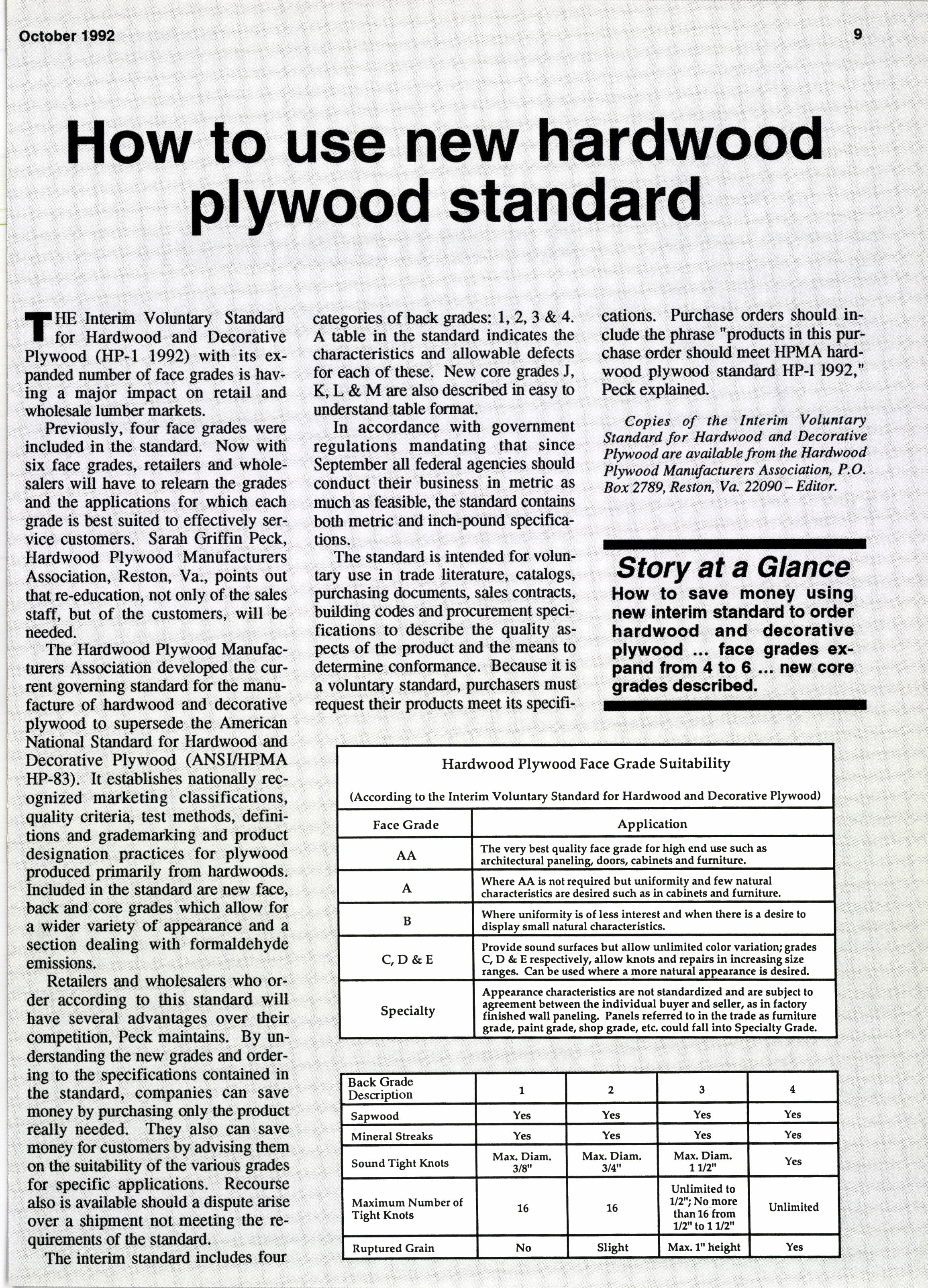
2 minute read
How to use new hardwood plywood standard
THE Interim Voluntary Standard I for Hardwood and Decorative Plywood (HP-l 1992) with its expanded number of face grades is having a major impact on retail and wholesale hmtber markets.
heviously, four face grades were includpd in the standard. Now with six face grades, retailers and wholesalers will have !o relearn the grades and the applications for which each grade is best suited to effectively service customers. Sarah Griffin Peck, Hardwood Plywood Manufacturers Association, Reston, Va., points out that re-education, not only of the sales staff, but of the customers, will be needed.
The Hardwood Plywood Manufacturers Association developed the current goveming standard for the numufacture of hardwood and decorative plywood to supersede the American National Standard for Hardwood and Decorative Plywood (ANSI/HPMA HP-83). It esrablishes nationally rmognized marketing classifications, quality criteria, t€st methods, definitions and grademarking and product designation practices for plywood produced primarily from hardwoods. Included in the standard are new face, back and core grades which allow for a wider variety of appearance and a section dealing with formaldehyde emissions.
Retailers and wholesalers who order according to this standard will have several advantages over their competition, Peck maintains. By understanding the new grades and or&ring to the spwifications contained in the standard, companies can save money by purchasing only the product really needed. They also can save money for customers by advising them on the suitability of the various grades for specific applications. Recourse also is available should a dispute arise over a shipment not meeting the requirements of the standard.
The interim standard includes four categories of back grades: 1,2,3 & 4. A table in the standard indicates the characteristics and allowable defects for each of these. New core grades J, K, L & M are also described in easy o understand table format.
In accordance with government regulations mandating that since September all federal agencies should conduct their business in metric as much as feasible, the standard contains both meric and inch-pound specifications.
The standard is intended for voluntary use in rade literature, catalogs, purchasing documents, sales contracts, building co&s and procurement specifications to describe the quality aspects of tte product and the mean$ to determine conformance. Because it is a voluntary standar( purchasers must request their products meet its specifi- cations. Purchase orders should include the phrase "products in this pufchase order should meet IIPMA hardwood plywood standard HP-l 1992," Peckexplained.
Copies of the Interim Voluntary Stand.ard for Hardwood. and Decorative Ptywood are ovailablc from thc Hardwood Plywood Manufacture n Association, P.O. Box 2789, Reston, Va 2209O - Editor.
Story at a Glance
How to save money using new interim standard to order hardwood and ecoratlve plywood face grades expand from 4 to 6 ,.. new core grades described.
Hardwood Plywood Face Grade Suitability
(According to the Interim Voluntary Standard for Hardwood and Decorative Plywood)
Face Grade Application
AA The very best quality face grade for high end use such as ilchil€ctual Daneling- doors, cabinet6 and fumiturc.
A Where AA is not required but uniformity and few natual characteristics are desired such as in cabinete and fumitue.
B Where uifomity is of less interest and when there i6 a desire to display small natural characteristics c,D&E
Provide sound surfaces but allow unlinited color variation; Brades C, D & E respectively, allow knots and repaire in increasing size ran*ee. Can be used where a more natual aDpearance is desired.
Appeuance characterbtiG ar€ not standardizrd and are subiect to agreem€nt between the individual buyer and seller, as in fac{ory finlshed wall paneling Panels refened to in the trrde as fumiture grade, paint grade, ehop grade, etc. could fall into Specialty Grade.










